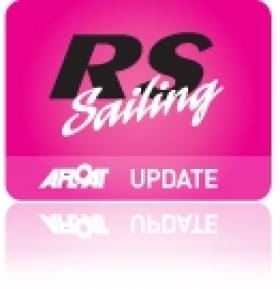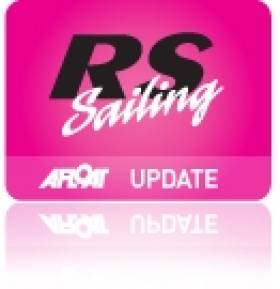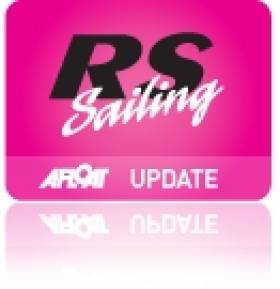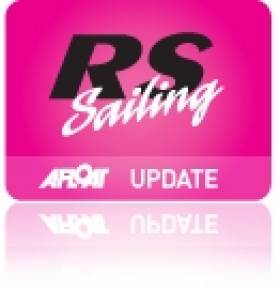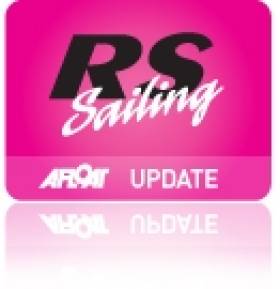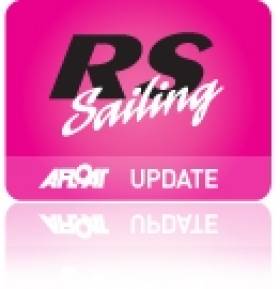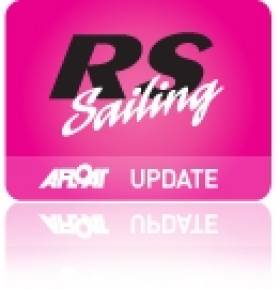Displaying items by tag: RS
Irish RS Fleets Announce 2013 Fixture List & Websites
#rssailing – Following the success of the 2012 season where the Dun Laoghaire and Cork based Fevas joined the big sisters' RS200/400 regattas at a joint Nationals, the class hope to introduce the younger Northern Irish sailors to the thrill and tactics of asymmetric Feva racing and look forward to more Fevas in the wider Irish RS event circuit in 2013.
The Feva association will be presenting their 2013 event Calendar in the near future.
Although the RS200 fleet has been largely Greystones based for many years, recent expansion in Dun Laoghaire and the North now threatening those comfortable at the top of the fleet while the Greystones youth sailors graduating out of Fevas and into RS200 and RS400s are hot on the transoms of their older rivals providing greater competition across all levels of the class, North and South and some earnest and fun-filled apres-sailing across the generations!
The fleets were surveyed this season to see what they felt was important both in terms of growth and also in communication, and as a result, the decision to circuit through the established clubs in 2013 was taken, to try to further establish the base clubs of Greystones, Royal North and Royal St George, but also to bring on the growth at Ballyholme and Cork. The hope is to take one day events to as many interested clubs as possible, the North seeing several new clubs adopting the RS400 in particular, with Cushendall and Newcastle already well established, but Coleraine, Strangford Lough, and East Down showing enthusiasm for the asymmetric classes.
Members are always keen to get new members out, with taster days and trial runs being esily arranged, so we would encourage anyone interested, to contact anyone on the committee, or post on the Facebook Page http://www.facebook.com/pages/Irish-RS-Dinghy-Association/153793291318773 or the Facebook Group http://www.facebook.com/groups/412080215518344.
The RS200 and RS400 are re-launching new websites for 2013, under the umbrella of the hugely successful International RS Association http://irl.rs200sailing.org/index.asp?Fleet=RS200 and http://irl.rs400.org/index.asp?Fleet=RS400. Circuit calendars can be found at these addresses.
The Irish Nationals are in Royal North of Ireland Yacht Club in July this year, which is concurrently the second leg of the Eurocup, and an event which traditionally attracts some quality competition from the highly competitive UK fleets.
Sportsmanship to the Fore at Dun Laoghaire RS Sprint Event
#rssailing – There was just a whisper of a building breeze as RS fleet launched from the George slip into a rather becalmed Dun Laoghaire harbour. Activity in the harbour built with the breeze during the afternoon with junior winter training for Lasers, Fevas and Oppies, sailing instructor courses, adult learners in Squibs and Picos, all close to the RS racing area. Full results downloadable below as a pdf document.
PRO's Barry O'Neill and Howth's Paul "PK" Kavanagh had stressed the sportsmanship nature of the Sprint event ethos where the start, sailing the shifts and mark rounding would prove so key in such a shifty breeze. As the wind shifted, marks were moved and the reaches tightened, the race course demanded new tactics with each gun. Superb race management allowed 12 races for all competitors with just enough time for a sip of water between the rolling starts. Valerie Kinnear and her team on the finish boat had their work cut out, with only inches and seconds separating the finishers of each fleet.
The start line was short, crowded and noisy with clear air hard to find. In the RS200s, local team Sean Craig and Heather King shot off in to the lead which was maintained throughout the afternoon with 10 out of 12 firsts. 2nd and third were valiantly battled out between 3 Greystones boats, Frank O'Rourke, Graeme Noonan and Sarah Byrne, all of whom had a mixed bag with no discards available, Sarah was squeezed out with Graeme just taking second and Frank third. 15 year olds Aaron Jones & Conor Cleary team managed to take a first from the more experienced helms, making their day and securing the Junior prize. Sarah & Ciara Byrne took first ladies.
In the 400s, Paul McLaughlin and Mick McKinley from Chusendall finally fulfilled their promise with a win over a strong fleet, with consistency combined with aggressive starting technique, which saw them rarely out of the top 4 in the no discard series. Emmet Ryan and bro James were runners up after finding their own personal dead spot of breeze in the final race. Gerry Cannon and Nicola Smyth showed great consistency all day to finish third.
All in all a very well-run event and a fitting climax to a very successful season for the RS classes. Thanks to all at RStGYC for laying on a great day's entertainment.
Greystones Event Concludes 2012 RS Sailing Circuit
#RS – The weather Gods promised lots of wind, then none, then some, and then in the end there was some, then none.
That said, the excellent Race Team managed to get 3 terrific races in on Saturday in a shifty F1-2, and even more impressively managed to squeeze something out of nothing to get a two lap race in on Sunday morning when it looked like nothing would happen.
14 RS200s were immediately under pressure from local form man Graeme Noonan, who was ably assisted by the top crew Heather King, fresh from helping Trevor Fisher to top spot in the 200s at the Northerns a few weeks ago. The team put in three bullets on Saturday, and were only topped on Sunday when a left hand shift in the start sequence caught all but Roy van Maanen and Glen Reid on the hop, and they were able to launch a mighty port tack start on the pin, to clear the fleet by 40 metres and disappear off the radar to take the win. As usual, lots of jockeying for the rest of the spots, with Frank O'Rourke finishing third overall behind Van Maanen.
Top Junior boat in the 200s were David Johnston and Louise Flynn-Byrne of Howth Yacht Club.
In the 400s, with 15 entries, Bob Espey and Michael Gunning were making short work of the job, by leading home the first two races, before coming under pressure in Race 3, being caught out by some left shifts coming off the land in the dying breeze, to count a 4th in race 3. With some better sleep on the Saturday night, and some readjusted drinking techniques, they were quickly into the groove on Sunday to hold off Sean Cleary who sailed a great race after a cheeky port tack start, to raise them to third spot overall. Despite getting a Black Flag on the Sunday morning, Paul McLaughlin and Mick McKinley from Cushandall had done enough on Saturday to hang on to second spot. Rob Hastings (Bosun Bob) sailed a blinder to really up the ante and picked up fourth, whilst Andy Verso and Oisin Baugh continue to show great promise to pick up top Junior boat. Brian Holmes started to move forward, despite his dental issues and vomiting during Saturday, and a warm welcome to newly weds, Avril and David Doherty of Monkstown in Cork, who arrived with next to no time in the boat, and showed it won't be long before they are fully in the thick of it. Great too to see a girl driving an Irish 400, showing us all that it is not just a bloke's boat to helm. Sufficiently impressed were we, by their enthusiasm, that we are convinced that we should visit Cork for the Southerns in 2013, and have our Nationals there in 2014.
In the Fevas, Emer Rafferty and Roseanne Cassidy from the George took top prize ahead of Molly Wheeler abd Megan Callen of Howth YC.
So that concludes the circuit for 2013, with just the Sprints in 2 weeks time at RStGYC in Dun Laoghaire on Saturday 20th October. Some new faces will be appearing for that one, as new, second hand 400s (if you know what I mean) especially, are being purchased on a weekly basis, which should boost the fleet greatly next year. We are hoping to see James Espey, Ireland's Laser Olympian straight legging it for entire races next season, as well as a smattering of new faces (mostly blasters from the past) joining the fray – all very exciting times for the RS fleet
Thanks of course to Greystones Sailing Club for laying on the usual great hospitality with complimentary burgers and healthy side dishes with green stuff and beans for the hungry arrivals ashore, and a great evening in the clubhouse with the rugby on the big TV, a smashing meal and a real welcome for the visitors, which went on the wee small hours – great stuff Greystones!
North and South RS Sailors Converge on Hospitable Strangford Lough Yacht Club
Fifteen RS 400s, from as far South as Glandore and as far North as Cushendall formed the main appetiser for the latest RS Ireland traveller series event. A smaller group of RS200s and RS Fevas also battled it out over the two days of the RS Northern Area Championships on glorious Strangford Lough. The racing came courtesy of the most hospitable of hosts at Strangford Lough Yacht Club and their team headed up by Emily Smith and Charlie Horder.
Saturday's racing was a blustery game of snakes and ladders with the RS 400 fleet continually trading blows and producing a different winner in each of the three races.
In the RS200's Heather Craig advised Trevor Fisher on how to do it, as they led overnight with three straight bullets.
In the Feva class, local boys Robbie and Peter Gilmore came good to lead overnight with an impressive score of 1, 3, 1.
The evening brought some "sensible drinking" and fine dining courtesy of event sponsors www.MashDirect.com . Rumours of some out of tune singing also circulated the following morning with some labelling it as Karaoke.
Sunday dawned a bit wet, but as the sun came out, it got even wetter for the back half of the RS 400 fleet as a whooping 30 knot right handed squall cuffed those taking too long to reach the windward mark in race 2, with entertaining variations on how not to bear off, hoist, gybe, stack it etc. Those who did set kites, (which was all but one) where treated to a somewhat out of control reach, (in which most helms would agree, they played very little part) as the mild mannered 400s decided they would steer themselves safely at 20 knots to the downwind position some 200 metres to the right of the last mark. Much swimming was done. There was a welcome rest whilst the PRO rearranged the course for the final race, in lovely sunshine, with some cheeky puffs that allowed all to arrive ashore nicely enthralled by the day's activity.
In the final mix, the Ballyhome duo of Bob "The Laser" Espey and Michael "The other Laser" Gunning took top spot by in RS400 class. Five different winners in six races showed that it was no push over for the lads.
In the RS200 class Heather Craig and Trevor Fisher had the luxury of discarding a second place, the only blot on an otherwise perfect score card to round out a clinical win.
In the Feva class Robbie and Peter Gilmore continued with Saturdays fine form with a 2,1,1 score to take a decisive victory. Perhaps Santa might have to squeeze an RS200 down the Gilmore chimney this year!
Next up for the Irish RS Classes is Greystones and the Sothern Championship on 6th and 7th of October. The local contingent will no doubt be ready to repel the Northern invaders, who are currently very much growing in strength and numbers.
#rs – Greytones sailors occupy the top three places of the RS200 national championships fleet after three races sailed in Howth today. Roy Van Maanen and Glen Reid lead from clubmates Graeme Noonan and Brian McCarthy. Full results here. In the 24 boat Feva class UK travellers Elliot Wells and Jake Tood from Haylng Island SC are the leaders after three races. There are no results currently posted in the RS400 class also competing in Howth. Scroll down for photos by Gareth Craig.
#RS – UK visitors are among the teams expected to compete in the RS Class National Championships - incorporating the RS Feva, RS200 and RS400 divisions - that will be hosted by Howth Yacht Club from August 17th-19th. A schedule of 10 races for each class is planned by top race officier David Lovegrove and his team.
Entries for the 3-day event from North and South of the border are expected for the RS200 and RS400 championships while the RS Feva event will feature boats from the established fleets in Dun Laoghaire, Greystones, Cork and the host club plus some UK boats travelling over too.
The Feva is a familiar sight in Howth and event chairman Chris Howard says his team are looking forward to also welcoming the 'bigger sisters' in the RS Class for the National Championships which is being supported by a number of sponsors.
#RS – The second event of this year's RS400 and RS200 traveller series was held at Newcastle Yacht Club Co. Down. The picturesque race area at the foot of the Mourne Mountains proved to be a tough test for both crews and hardware. A strong force six westerly brought plenty of gusts and shifts down the course on both Saturday and Sunday. This provided lots of thrills and occasional spills. Two masts from the twenty six boat fleet paid the price on Saturday. Unfortunately for John Lowry and Emmet Connon, they lost their mast on completion of the final gybe to the finish line with a healthy lead over the rest of the RS400 fleet.
Despite the challenging conditions, race officer Robin Gray from Ballhomle and his team did a top job to knock out six races for the two classes.
In the fourteen strong RS400 fleet, reigning national champion Simon Herriott and Shane Mac Carthy came out on top. They were pushed all the way by Paul Mc Laughlin and Michael Mc Kinley from Cushendall, with the pair only two points off top spot. Brothers Emmet and James Ryan from The Royal St George finished in third place. With multiple race winners over the two days the overall standard in the Irish 400 fleet is certainly starting to tighten up. Any minor mistakes were severely punished.
In the twelve boat fleet of RS200's, Graeme Noonan and Brian Mac Carthy dominated proceedings. The pair had a convincing win, scoring five firsts and a second. Current national champions Roy Van Maanen and Glen Reid had a comfortable second place. Local Newcastle crew, Clive Coffey and Helen Cassidy took the final podium spot.
Next up for the RS fleet is the Irish Nationals which will be held at Howth Yacht Club from the 17th to the 19th of August.
Four Firsts for Craig's New RS200
#RS SAILING – The RS400, RS200 and RS Feva traveller series kicked off this weekend on Lough Ree Yacht Club.
A brisk North-Easterly blowing down the Lough greeted the RS teams on Saturday morning. The conditions were made tougher with a sharp chop, heaped up by the gusty conditions. Not "ploughing the bow" into the waves was the key to upwind speed. Remaining in full planning mode and keeping the show on the road in the gusts was the order of the day downwind.
Race officer Vincent Rafter and event organiser Donal Herraghty did a fantastic job to squeeze four windward leeward races in on Saturday in anticipation of the gale-force winds that led to Sunday's racing being cancelled. The quick turnaround between races was greatly appreciated by everyone on the water.
In the RS400's former 49er campaigner Robert Espey and crew Michael Gunning from Ballyhome Yacht Club took the top stop. The pair finished level on points with Simon Hutchinson and Trevor Darcy from the Royal North but took top spot with a lower discard. The Royal St George pairing of Emmet and James Ryan finished in third place.

The level of quality in the RS400 fleet has certainly risen with some high calibre additions to the class. The strength of the Northern fleet which had fourteen RS400's competing in the Ballyhome Icebreaker Series this winter was certainly evident in the testing conditions.
In the RS200's it was Sean and Heather Craig from the Royal St George who came up trumps with a perfect score card of four firsts. The battle for second place was tight, with Clive Coffey and Helen Cassidy from Newcastle Yacht Club edging out the Royal St George father and son pairing of Ian and Tom Simington on count back.
In the ever popular RS Feva's the top spot went to Dan and Conor O'Bernie of the Royal St George who piped local Lough Ree sailors Tiarnan Dickson and Caolan Croasdell on count back. Third place went to Blathnaid and Rosanna Cassidy of the Royal St George.
Top three results in each class:
RS400: 1stRobert Espey & Michael Gunning (BYC) 2ndSimon Hutchinson & Trevor Darcy (RNIYC) 3rdEmmet Ryan & James Ryan (RStGYC)
RS200: 1stSean & Heather Craig (RStGYC) 2nd Clive Coffey & Helen Cassidy (NYC) 3rdIan & Tom Simington (RStGYC)
RS Feva: 1stDan & Conor O'Bernie (RStGYC) 2ndTiarnan Dickson & Caolan Croasdell (LRYC) 3rdBlathnaid & Rosanna Cassidy (RStGYC)
RS Classes Head Inland to Lough Ree
The Irish RS Dinghy Class Association Inland Championship is set to take place at Lough Ree Yacht Club on the weekend of the 28th and 29th of April.
This will be the first time the Feva class will join up the RS200's and RS400's for a regional event. It will also be the inaugural RS Inland Championship. The Notice of Race is available to download below.
No doubt the ever popular Feva's will be sharp following on from The ISA Mitsubishi Youth Nationals this weekend.
The RS200's and 400's classes have seen very strong growth over the past season and are sure to be hotly contested.
The RS200 which is seen as the natural progression from the Feva has seen the class starting to emerge in new areas along with the traditional stronghold of Greystones. Dun Laoghaire is now home to five 200's. Newcastle YC in Co. Down now boasts a fleet of five 200's and Howth YC recently saw the arrival the first 200 to the club.
The RS400 has seen similar growth with five Dun Laoghaire based 400's, the continually growing fleet in Greystones and a very strong showing in the North were no less than fourteen RS400's contested the Ballyhome Icebreaker series.
With such a strong calendar it all bodes well for the upcoming season and the continued growth of all three classes.
|
2012 RS Events 28-29 April 2012 |
Inlands |
Feva,200/400 |
Lough Ree YC |
|
30 June & 1 July 2012 |
Easterns |
Feva,200/400 |
Newcastle |
|
23-27 July 2012 |
Eurocup |
RS classes |
Lake Garda, Italy |
|
17-19 Aug 2012 |
Nationals |
Feva,200/400 |
Howth YC |
|
19-23 Aug 2012 |
UK Nationals |
RS 200 |
Exe SC |
|
8-12 Sept 2012 |
UK Nationals |
RS 400 |
Royal Torbay YC |
|
15-16 Sept 2012 |
Northerns |
Feva,200/400 |
Strangford Lough |
|
6-7 Oct 2012 |
Southerns |
Feva,200/400 |
Greystones |
|
20 Oct 2012 |
Sprint |
RS 200/400 |
RStGYC |
RS200/400 Demo at Royal St George Next Weekend
#RS SAILING - UK RS Association chairman Pete Vincent will be running another RS200 and 400 demo day from the Royal St George Yacht Club on the weekend of 24-25 March.
The well-known expert on RS boats is being brought to Dublin by RS400 owners Richard Tate and Emmet Ryan, who are "really keen to get an RS fleet up and running" in Dun Laoghaire.
"After the huge attention our boats have drawn both ashore and on the water, we feel there is already a keen interest from a broad cross section of sailors to learn something more about these incredible hiking dinghies," says Tate.
"There is a ready-to-race format for both RS200s and 400s to have a full season of racing every Tuesday and Thursday in Dublin Bay right from the go."
The RS200 is described as a "natural progression" from the RS Feva, while the RS400 "takes the concept one step further and way beyond". Both classes provide high performance assymmetrical racing for all age groups.
If you are thinking about moving into an RS200 or 400, this is the perfect opportunity to help you make your decision.
All demo sails must be booked in advance by contacting Pete Vincent directly at +44 7812 899 043 or [email protected].




























